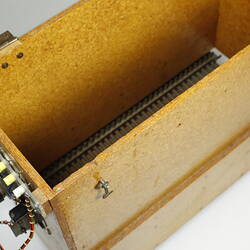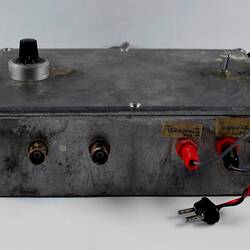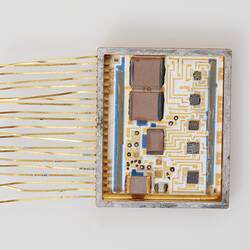Summary
Alternative Name(s): Experimental Box for avoidance conditioning
Made by Department of Otolaryngology, University of Melbourne - Bachelor of Medical Science students John Nathar, Harry Minas and Howard Kranz.
Initial physiological and behavioural research on the experimental animal was carried out by Graeme Clark to see if electrical stimulation of the hearing nerve could reproduce the frequency coding by the brain. This required inserting stimulating electrodes into the auditory nerve and recording electrodes next to the auditory brain stem cells. Their responses to sound were compared with those for electrical stimulation. Clark considered his brain cell results had to be confirmed in the alert, behaviourally responsive animal. The tests had to be learned and were conducted by conditioning the animal in an experimental box. The animal learned to respond to the sound and then the electrical stimuli.
This research showed that rate of stimulation on a single electrode would not transmit the important speech frequencies and it would be necessary to use multiple electrodes inside the inner ear to convey speech. While this indicated that a prototype multiple-channel cochlear implant would be needed to test whether deaf patients could understand running speech, ear surgeons and other scientists considered it was not safe to put multiple electrodes inside the inner ear to do this. For this reason Clark carried out a number of safety studies on the experimental animal to ensure that there would not be damage to the very nerves it was hoped to stimulate, and infection studies to minimise the risk of meningitis. This was done before operating on patients.
Significance
The bionic ear (also known as the cochlear implant) is the result of pioneering research commenced by Professor Graeme Clark in the late 1960s at the University of Melbourne's Department of Otolaryngology. At the time it was considered that the production of a successful cochlear implant would be extremely difficult making Government funding opportunities almost impossible. Professor Clark and his staff sought donations from the general public to originally get the project off the ground. Assistance from clubs such as Rotary, Lions and Apex was invaluable at this time.
The prototype multiple-electrode bionic ear was implanted in the first adult at The Royal Victorian Eye and Ear Hospital by Graeme Clark and colleagues in 1978. The team discovered a way to analyse complex speech signals and present it to the auditory nerve as electrical stimulation in a way that could be deciphered. They were able to engineer a speech processor small enough for a patient to wear.
As a result, the Australian Government awarded a public interest grant that helped develop the bionic ear industrially by the Australian firm Cochlear Limited. The first device for clinical trial world-wide was implanted at the Royal Victorian Eye and Ear Hospital in 1982. The international trial established that it was safe and effective and it was approved by the US Food and Drug Administration in 1985, the first multiple-electrode bionic ear to be approved by any world regulatory body.
In 1985, the team implanted the first child with a multiple-electrode bionic ear. It was developed and manufactured by Cochlear Limited in co-operation with The University of Melbourne and The Bionic Ear Institute. This was the start of a world-wide trial for the bionic ear in young children. It was approved as safe and effective for use in children born deaf or developing hearing early in life by the US Food and Drug Administration in 1990. It has also been approved by other world regulatory bodies. It is considered by many the first major advance in helping profoundly deaf children to communicate in the last 200 years since signing was established at the Paris Deaf School. The Australian Bionic Ear has now been implanted in more than 50,000 people in more than 120 countries.
Research work on the bionic ear requires collaboration between many fields. They include auditory neurobiology, auditory physiology and perception, bionics programming, psychology and neuro-engineering. In developing the bionic ear, much has been learned about nanotechnology and biotechnology including: tolerance of surgical implants by the body; interfacing electronic devices with nerves and the brain; improving speech understanding and language in deaf people; and repairing nerves. Today the knowledge of biomaterials is not only applied to hearing, but also to tackling spinal injury and epilepsy.
Graeme Clark has lodged some artefacts with the National Museum of Australia. He has also deposited material with the National Film and Sound Archive.
More Information
-
Collection Names
-
Collecting Areas
-
Acquisition Information
Transfer from University of Melbourne (The), Cochlear Pty Ltd, 12 Nov 2008
-
Lead Researcher
Professor Graeme M. Clark AC - University of Melbourne (The), 1973
-
Classification
-
Category
-
Discipline
-
Type of item
-
Object Measurements
235 mm (Length), 155 mm (Width), 175 mm (Height)
-
Keywords
Australian Innovations, Disabilities, Disability Technologies, Hearing Aids, Hearing Impaired, Innovation & Design





